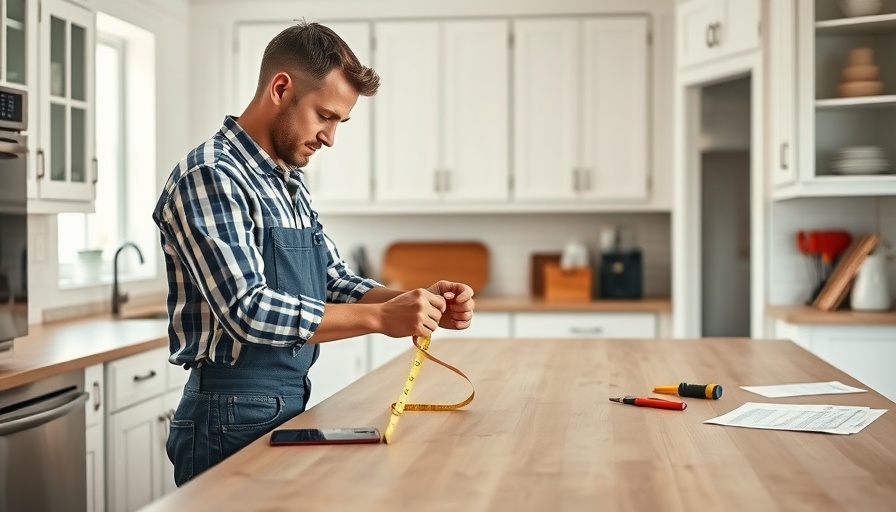
Understanding the Essential Dimensions for Your Kitchen Countertops
When embarking on the journey to replace or install new kitchen countertops, having a firm grasp on the standard dimensions is crucial for both functionality and aesthetics. Most commonly, kitchen countertops are designed to be between 25 and 25.5 inches deep. This depth accommodates the typical 24-inch deep base cabinets while allowing for a modest overhang.
The standard height for countertops is approximately 36 inches, measured from the finished floor to the top of the countertop material. This height has been optimized for comfort and usability, making it an ideal working surface for cooking, baking, and meal preparation.
As you consider lengths for countertops, it’s helpful to note that they typically range from six to ten feet, with extended options reaching up to 12 feet for more spacious kitchens. Geremy Yamamoto of Eazy House Sale notes, "Extended countertops are fantastic for creating additional workspace and seating options, enhancing the kitchen's functionality and flow." Understanding your kitchen's unique size and layout can significantly impact your selection process.
Key Considerations for Countertop Overhang
One of the pivotal elements in countertop design is the overhang, especially when incorporating seating options. The standard overhang typically ranges from 12 to 15 inches. Architect Matthew Coates advises, "While you can have a shorter overhang, aim for at least 12 inches to ensure comfort – anything shorter may compromise seating accessibility." If you choose to extend the overhang further, installation support via brackets or corbels is necessary to prevent potential damage.
Don’t forget to consider the heights of those who will be using the seating – taller individuals may need more space to sit comfortably without their knees hitting the countertop.
Measuring for Your Perfect Countertops: A Step-by-Step Guide
Now that you have a grasp on dimensions, let’s dive into measuring your kitchen countertops correctly:
- Measure All Sections: Begin by measuring the length and width of every section of the countertop. It's essential to account for irregularities in walls and cabinets that may affect the final fit.
- Sketch the Layout: An excellent practice is to create a sketch of your countertops, noting the placement of appliances, sinks, and stovetops, which can influence the design and covering of the materials.
- Account for Backsplashes: If installing a backsplash, plan for it to be at least four inches tall and running the entire length of the counter.
- Factor in Overhang: Include an overhang of 1 to 1.5 inches on the front of all sides not against a wall.
- Calculate Square Footage: Multiply the length by the width to get total square inches; then divide by 144 for the square footage. To cover material waste and errors, consider adding an additional 10% to your total.
The Importance of Planning Ahead for DIY Home Projects
Replacing kitchen countertops comes with a host of decisions — from style to material, each choice contributes to the overall kitchen aesthetic. Planning and accurate measuring are vital parts of this process, particularly for DIY enthusiasts looking to enhance their kitchen without breaking the bank. Understanding kitchen layout enables you to envision how different elements will interact and help you create a cohesive design.
Bringing it All Together: Countertop Material Choices
As you leap into this home improvement adventure, material selection will play a significant role. Popular choices include granite, quartz, laminate, and marble, each offering distinct qualities and aesthetics. Granite, known for its durability and natural beauty, often makes a strong case for high-traffic kitchens. Quartz provides a uniform look with less maintenance, making it ideal for the busy homeowner.
For those on a budget, consider laminate or butcher block as attractive, cost-effective options that can give your kitchen a refreshing upgrade. As you navigate your DIY home decor, the right materials can elevate not only the function of your kitchen but also its charm and character.
Going Beyond: Using Countertop Measurements in Home Improvement
While measuring for countertops may seem straightforward, it offers a broader lesson in the world of DIY home projects — accurate measurements can prevent costly mistakes and renovation delays. The principles learned through this process can be applied to other home decor aspects such as furniture placement, organization, and even painting. Remember, measuring twice often saves time and resources!
Every DIY project starts with an idea, but it’s the planning and attention to detail that transform that idea into reality. Whether you're a seasoned DIYer or just venturing into home renovations, understanding aspects like kitchen counter measurements lays the foundation for successful and enjoyable home improvement ventures.
 Add Row
Add Row  Add
Add 




Write A Comment